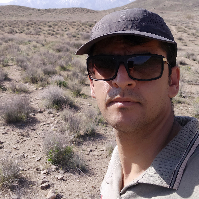Identification of Active Dust Source Areas Using Field and Remote Sensing Methods for Determining Wind Erosion Threshold Velocity (Case Study: Eastern Kerman Province)
This study was conducted in 2020 with the objective of identifying dust source areas and soil susceptibility to wind erosion in the eastern part of Kerman Province, through the integration of field and remote sensing methods. In total, ten study areas covering 3007 square kilometers were identified based on remote sensing and field surveys during the winter of 2020. The dust-prone areas and the determination of the dust event frequency in the past 20 years were established using the optical depth index derived from MODIS Terra and Aqua satellites. To assess soil erodibility, wind erosion threshold velocity, and wind erosion rates, soil samples (17 in total) were measured in a wind tunnel at three wind speed classes: 15, 20, and 25 meters per second. Electrical conductivity (EC) values of soil samples (22 in total) were determined in the laboratory to create a soil salinity map using the kriging method. The results of the vegetation cover index were extended, and the linear relationship between EC was computed using Google Earth Engine and compared with kriging results, indicating significant salinity in the studied areas (EC>16). The analysis of prevailing wind directions and wind regimes based on data from five meteorological stations in the region demonstrated that the Rigān and Nasratābād stations, with transport potential of 561 and 1199 kg m^-1 s^-1, respectively, were classified as high-energy wind zones. Wind speeds of 40 knots (20.57 m/s) were prevalent in these areas. The assessment of soil erodibility revealed that the southern parts had the lowest wind erosion threshold velocity (between 6 to 8 m/s), classifying them as wind erosion-sensitive zones, with an accumulated wind erosion rate of 60 kg/m^2/year across the three wind speed classes. Based on the findings, the study areas are considered significant internal dust source areas, requiring management actions to control dust emissions.
-
The Challenges of Desertification in Iran with a Focus on Water Resources Policies
Ahmad Rahmani *, Khosro Sagheb Talebi, Ali Talebi, Hasan Ahmadi, Gholam Reza Zehtabian, Mohammad Khosrowshahi, Mehdi Zarghami, Ali Salehpour, Bagher Ghermezcheshmeh, Gholam Reza Haderbadi, Mohammad Danesh, , Seid Jafar Seid Akhlaghi, Arezoo Ashrafizadeh, Samaneh Razavizadeh
Iran Nature, -
Using Sentinel radar and optical data in the Google Earth Engine platform to determine the extent of land use changes in Alborz Province
*, Zahra Mohammadesmail, Mansour Chatrenour
Journal of Land Management, -
Land management approaches to mitigate dust in the southeastern dust source of Ahvaz
*, Adel Jalili, Mohammad Khosroshahi, Mohammad Fayaz, , Hasham Kenshloo, Azadeh Gohardoust, Koroush Behnamfar, Mehri Dinarvand, Banahsheh Yasrbi, Seyed Jafar Seyed Akhlaghi, Fatemeh Dargahian, Samira Zandifard, Sakineh Lotfinasabasl, Samaneh Razavizadeh, Shahram Safie, Lila Zanozi, Tahereh Mogadam, Zahra Saaifefar, Sara Teimouri, Yaser Gasemi, Nacim Bagheri, Fatmeh Keneshloo, Maryam Naimei, Hossin Arami, Sajad Alimahmoodi Sarab
Iranian Journal of Forest and Range Protection Research, -
Land suitability evaluation for poplar plantation
H.R. Abbasi *, F. Khaksarian, R. Bagheri, A. Salehi, F. Asadi
Iranian Journal of Forest, -
Changes in Agricultural Land Use as a Threat to Food Security
Mirnaser Navidi *, Hadi Asadi Rahmani, Mansour Chatrenour, , Mohammad Jamshidi, Alireza Ziaee Javid, Zahra Mohamadesmaeil, Fatemeh Ebrahimi Meymand
Journal of Land Management,






